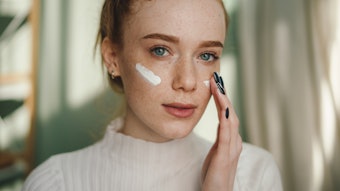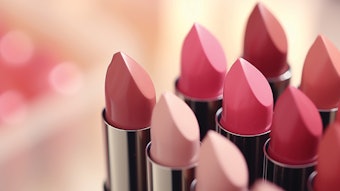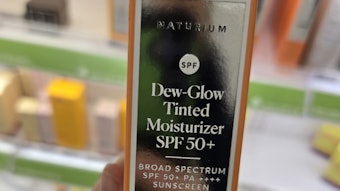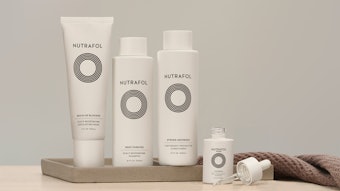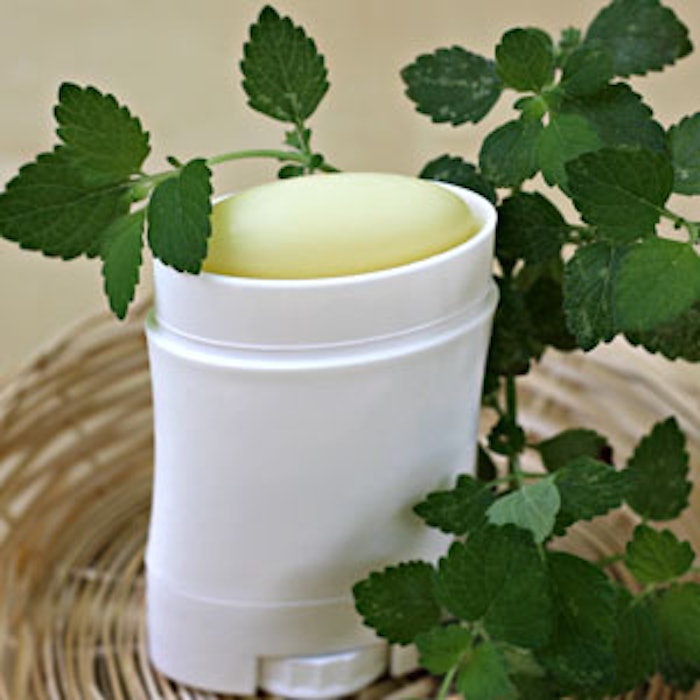
Within the realm of natural and organic personal care products, deodorants and antiperspirants loom large simply because the overall category itself is very large in any retail health and beauty aids planogram. These two related products—i.e., antiperspirants and deodorants (AP/Deo)—are fraternal twins joined at the axilla that perform in this same anatomical arena using some of the same tricks. This sibling rivalry has been dominated in the past few decades by antiperspirants with ever-increasing claims for sweat reduction efficacy and odor reduction.
Lately, however, the industry has seen the proliferation of natural market-targeted deodorant entries. The primary reasons for this are the perceived unnatural blocking of sweat glands and alarmist concerns over the safety of aluminum—concerns that are based on misinformation and the supposition that aluminum has systemic toxicity when applied topically. Also, since in the United States claims for anti- perspirant activity are drug claims, and all approved over-the-counter (OTC) drug actives are aluminum salts, the industry does not see any natural antiperspirant actives. What is seen is the use of potassium alum—interestingly, its full name, potassium aluminum sulfate, is almost never used, most likely to mask this salt; however, this ingredient has been judged ineffective as an antiperspirant under the same OTC monograph.
From a physiological perspective, blocking this small axillary portion of the eccrine sweat glands would do little to affect their essential function of maintaining the temperature of the body in its overall larger cooling and heating system. In the original introductory publication from the US Food and Drug Administration (FDA), the so-called Advance Notice of Proposed Rule Making (ANPR) in October of 1978,1 the expert panel stated that “it had been repeatedly demonstrated” that even total blockage of axillary sweat did not compromise the control of body temperature. However, the panel feared that total body inhibition “might interfere with the thermal regulatory process” and thus concluded that antiperspirants should not be permitted for use over the entire body.
In addition, while no federal agency is infallible, and new evidence eventually gets the FDA’s attention, there has not been sufficient enough concern to drive aluminum salts into Category 3, i.e., “needs more data to support safety and efficacy”; nor Category 2, either “not safe” or “not effective.” Controversy still surrounds aluminum’s implication in some chronic diseases but most evidence suggests a benign toxicology profile for the element, even though trivalent aluminum can wreak havoc on anionic colloidal systems in the beaker and/or the test tube.2
Human Body Odor
According to the IFSCC monograph on underarm technology,3 individuals have been trying to control body odor for at least 3,500 years; the earliest methods are attributed to the Chinese, who mixed aromatic gums with fats to form an unguent to mask odors on various body areas. This perfumery solution continues to the present and has been supplemented with antimicrobial compounds like zinc oxide in the late 19th century, and antiperspirant aluminum salts in the early 20th century.
To understand the function of deodorants, it is first helpful to consider the etiology of human body odor. Although the eccrine glands are the primary target of antiperspirant salts to block the flow of sweat, it is the apocrine glands that secrete the nutritional milk on which commensal microbes feed to produce the low molecular weight organic acids 3-methyl-2-hexenoic acid (TMHA), primarily, and the steroidal compound androstenone. Consider the ecology of the human skin as Marples did more than 40 years ago.4 The skin is populated by an unusual distinct and invisible (crypto) flora and fauna that differs based on different body sites, body secretions and conditions of temperature and humidity—i.e., human microbiomes. Within these skin environments thrive the most important microbes responsible for body odors, the Gram-positive Corynebacteria, which take the aforementioned apocrine secretions and generate the familiar body odors in the high humidity chamber where both apocrine and eccrine glands abound, i.e., the axillae. Interestingly, beyond the stratosphere, experiments in human body odor were conducted on both American and Russian astronauts as they hurtled through the cosmos. Although the men were given provisions for personal hygiene, including non-rinse cleansers and shampoo, the space explorers found that equilibrium was reached after a week or two. An odor plateau came about as the amount of secretions leveled off with the number of bacterial colonies on the skin degrading those secretions.5
This observation may partly explain why the Middle Ages did not witness consistent bathing practices, and people simply changed their clothes or applied aromatic oils to mask their natural scent. They became accustomed to their neighbor’s aromas in their generally high intensity but stable atmosphere. Today however, society generally does not abide these natural human pheromones and instead accepts only synthetically formulated ones—witness the proliferation of fine fragrances for men and women. But every population responds to body odor differently based on its level of tolerance and familiarity. For instance, odors wafting through a city subway during rush hour may initially catch an out of town tourist off guard but the acclimated daily riders may be unaware of the same odors, even on a hot afternoon.
Natural Solutions
So how can this natural process that results in these natural odors be controlled via a natural solution? Consider the three approaches to malodor control as outlined in the IFSCC monograph, i.e., odor-masking, odor reduction and odor prevention.
Odor-masking: The masking of body odor can be accomplished with counter odors of pleasant or distracting scents—the province of perfumery. One can use the vast array of essential oils and pure natural compounds on the perfumer’s palette to accomplish this. Some of these ingredients are also effective at odor prevention as they exhibit anti- microbial action as well. In fact, there is a whole category of perfume compositions called deofragrances that can be compounded with natural materials if one is willing to pay the price and accept the labeling requirement for the 26 fragrance allergens.6
Odor reduction: The second strategy of odor reduction can be accomplished by absorbing the body’s odorous compounds such as valeric acid (C5-pentanoic acid), a major component of typical foot odor. Odor absorption is accomplished through the use of both inorganic media—i.e., clay, bicarbonate powders and zeolites, and organic media—i.e., corn starch and arrowroot powder, as well as odor decomposition via enzymes such as saccharomyces ferment. These materials have absorption potential for odorous molecules due to either their porous nature, as in zeolites; simple adsorption of mineral powders, such as kaolin clays; and potentially reactive adsorption for alkaline materials like bicarbonates, where a modest exchange potential exists for weak volatile organic acids, which are a major component of body odor.
Odor prevention: Lastly, odor prevention by bacteriostatic or antimicrobial action can be affected via a variety of materials and techniques. Conventionally, the ubiquitous synthetic ingredient triclosan, an FDA-approved antimicrobial drug active, is used for odor prevention. This bacteriocidal compound finds its way into a wide range of personal care and household products including many dish washing liquids, which must list a Drug Facts box on the label due to their triclosan content. With only a few tenths of a percent of this active ingredient incorporated therein and the attendant claims on the label, violà—an everyday dish detergent transmutes into a topical OTC drug. One may wonder why this ingredient has not supplanted the strongly phenolic-smelling para-chloro, meta-xylenol (PCMX) in hospital and health care hand cleansers. Perhaps the industry prefers that residual scent to remain to confirm that workers have washed.
For naturally certified products, one must turn toward the growing range of inorganic and organic ingredients, in chemical parlance, with bacteriostatic and/or antimicrobial activity. Zinc oxide was used in the late 1880s in deodorant creams3 such as the Mum branda and is positively listed in nongovernmental organization (NGO) certifier standards such as Ecocert.7
Alternate zinc compounds such as zinc citrate are also used, and some may have dual activity based on fatty acid combinations; e.g., zinc undecylenate. Another typical inorganic salt used—both in a concentrated dissolved form, and a solidified nearly 100% form—is potassium alum and its cousin ammmonium alum. These are both aluminum sulfate salts that occur naturally as dodecahydrates, i.e., with 12 moles of water. These salts inhibit bacterial growth and as such exhibit deodorancy but have been judged ineffective as antiperspirants.8 Note that some products such as the Thai Deodorant Stone are possibly mislabeled, having their active ingredients identified as a mineral salt (potassium silicate), which is more likely potassium alum, as are some other products from Thailand. Finally, atomic silver nanoparticles have been recommended for some products and may act as a reservoir for silver (Ag+) ions. Silver’s antimicrobial activity is reputed anecdotely to have been first discovered by the ancient Greek and Roman Mediterannean cultures.
Acceptable Ingredients
At this juncture it would be instructive to look at the U.S. Department of Agriculture’s (USDA’s) National Organic Program (NOP) enumeration of acceptable ingredients for certified organic products. Notwithstanding the USDA’s protests that these standards were promulgated for agricultural products and derived for processed foods, there are numerous agricultural ingredients that function in personal care. Beyond the large range of vegetable oils and other farm products that can be certified as organic, NOP-allowed substances include: xanthan gum, bentonite and kaolin clays as well as baking soda (a time-honored odor absorber, according to Tom’s of Maine).9 The full list of allowed materials identified in the USDA NOP guidelines are included in the current US Code of Federal Regulations.10 The range of excipients allowed by the pantheon of international natural and organic certifiers includes this range as well as legions more.
Considering the wide range of available bacteriostatic and antimicrobial ingredients, formulators can also choose from an ever-growing list of essential oils, their component chemicals and botanical extracts that inhibit microorganisms. In addition, there are other organic compounds made with allowable chemical processes such as esterification that have activity based on their molecular size and amphiphilic properties (see Table 1).
Among the latter, glycerol mono- laurate, the monoglyceride of lauric acid or simply monolaurin, came on the scene more than 40 years ago.11 Although the claim is for the C12 lauryl chain to be most effective, there has been recent work at some companies showing effectiveness for a variety of short chain amphiphiles. These include capryloyl glycine, glyceryl caprylate, caprylyl glycol—all variations on a C8/caprylic acid theme. Another option comes from a biotechnology platform, the sophorose lipid with the cumbersome INCI name of Candida Bombicola/Glucose/Methyl Rapeseedate Ferment. This biosurfactant from yeast is active against mostly Gram-positive organisms, which would target those implicated in body odor and acneb. The plant kingdom itself produces a great many phytochemicals that have varying levels of activity as bacteriostats and antimicrobials. A search of the USDA Ethnobotanical Database yields a modest number of plants and phytochemicals with bacteriostatic and deodorant activity.12 Results include both flavones and terpenoid classes and point to activity that hinges on phenolic functionality in many cases. The unique structures of lichen (Usnea sp.)
phytochemicals such as usnic acid are active against microbes and also have a polyphenolic character. Chlorophyll itself is used as a deodorant in one finished product as well as in certain oral products. Further, some products feature witch hazel although in deodorants, this distillate is probably only contributing a little fragrance and alcohol besides acting as a promotional marketing ingredient.
In greater abundance are certain essential oils and their component chemicals from plants that demonstrate bacteriostatic activity. Commonly used essential oils include tea tree oil, which contains a high level of terpinen-4-ol, the primary antimicrobial aroma chemical.13 Many other essential oil chemicals, especially those found in culinary herbs, have been investigated and found effective in retarding bacterial and fungal growth. The objective of many of these studies was to find acceptable natural herbs to prevent food spoilage. Parallel research discovered that rosemary constituents, especially rosmarininc acid, have significant antioxidant activity and this has been patented and commercialized. Notable among the herbs and their constituents that have been validated to inhibit microbial growth by some researchers are: oregano (thymol, carvacrol); coriander and rosewood (linalool); lemongrass (neral, geranial); savory (carvacrol); and cinnamon bark (cinnamaldehyde).14
Yet another natural way to eliminate odor is by attacking it as one yeast-derived complex reportedly does—with “enzymes that provide bioconversion of a wide range of malodorous substances” to address a broader range of issues in addition to axillary odorc. This complex is finding a place in successful commercial products from manufacturer Kiss My Face.
Formulating Considerations
Finally, one needs to deliver this deodorant cocktail in a consumer-acceptable carrier and in the case of deodorants, most fall into three forms: sticks, roll-on lotions and sprays. Sticks currently dominate, as can be seen by the general number and ratio of stick SKUs to other forms on local store shelves; roll-ons are a distant second. These so-called propel-repel sticks are primarily sodium stearate designed so that this surfactant forms lamellar association structures that order the system into a stiff liquid crystal. Solvent vehicles consist of a moderate amount of water mixed with other miscible glycolic and alcohol components. In addition, becoming more popular is the use of 1,3-propanediol made through a fermentation process.
Most functional deodorant actives are compatible in stick systems; see Table 2 for a natural deodorant stick master formulation. Interestingly, one unique group of stick products on the market are small, cylindrical bullets composed of compressed alum salts sometimes entirely composed of hydrated potassium alum. Besides sticks, roll-on liquids also can be formulated as simple thickened water base systems using clays and xanthan gum. And of course, sprays can be aqueous solutions of soluble or solubilized actives with or without alcohol. Take note that these materials do not all mix well like one happy paella stew or creamy boulabaisse; for example, the anionic stearate stick base will not tolerate alums, and all herbals do not always blend well. Furthermore, too many actives and salts can wreak havoc on any emulsion system, so start systematically with the base and add one ingredient at a time.
Concluding Remarks
From a survey of the market over the past few years, this category is growing with innovation in the combination of functional actives. The confirmation that these are actual innovations and not simply a shotgun approach to activity can only be determined with actual consumer-use studies. The smell will tell. The industry is still constrained to clinical sniff tests using trained graders, so take out those noses to see-or rather, smell what exotic combination works best.
References
- FDA, Antiperspirant drug products for over-the-counter human use, establishment of a Monograph part II. General statements and recommendations C. 2.e. Function of the gland, Federal Register 43(196) p 46701 (Oct 10, 1978)
- Aluminum, https://en.wikipedia.org/wiki/Aluminum#Natural_occurrence (Accessed Nov 14, 2011)
- E Abrutyn and J Wild, Antiperspirants and deodorants: Principles of underarm technology, IFSCC Monograph No. 6, Micelle Press (1998)
- MJ Marples, Life on the human skin, Sci Am 220 108–115 (1969)
- M Roach, Packing for Mars: The curious science of life in the void, available at: http://en.wikipedia.org/wiki/Packing_for_Mars:_The_Curious_Science_of_Life_in_the_Void (Accessed Dec 19, 2011)
- Fragrance Allergens, available at www.allergygeneral.com/forum/f8/fragrance-allergens-38.html (Accessed Dec 19, 2011)
- Ecocert SA, Standards for ecological and organic cosmetics, available at: www. ecocert.com/en/natural-and-organic-cosmetics (Accessed Dec 19, 2011)
- Proposed Rule 11: Classifies category II and III (Antiperspirant) ingredients without data as nonmonograph, available at www.fda.gov/Drugs/DevelopmentApprovalProcess/DevelopmentResources/Over-the-CounterOTCDrugs/StatusofOTCRulemakings/ucm070826.htm (Accessed Dec 30, 2011)
- Tom’s of Maine website, Good science: Ingredients, available at www.tomsofmaine.com/research/ingredients (Accessed Dec 19, 2011)
- USDA, e-CFR, Title 7: Agriculture, available at http://ecfr.gpoaccess.gov/cgi/t/text/text-idx?c=ecfr;rgn=div5;view=text;node=7%3A3.1. 1.9.32;idno=7;sid=bf165925f395353921ec628f936e9f2d;cc=ecfr#7:3.1.1.9.32.7.354.6 (Accessed Dec 19, 2011)
- Fatty acids and esters as multifunctional ingredients, in J Kabara and D Orth, eds, Preservative-free and Self-preserving Cosmetics and Drugs: Principles and Practice, ch 5, CRC Press/Taylor Francis: London (1997) p 119
- USDA Agricultural Research Service (ARS), Dr. Duke’s phytochemical and ethnobotanical databases, available at www.ars-grin.gov/duke/ (Accessed Nov 15, 2011)
- S Drury, Tea tree oil—A medicine kit in a bottle, CW Daniel Co. Ltd: UK (1991) p 11
- Knobloch et al, p 5; Baratta et Al, p 213; Chao et al, p 333; and Giamperi et al, p 438, in BM Lawrence, ed, The Antimicrobial/ Biological Activity of Essential Oils, Allured Business Media: Carol Stream, IL USA (2005)
